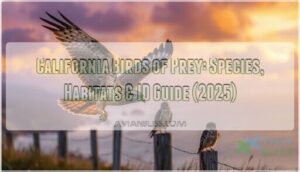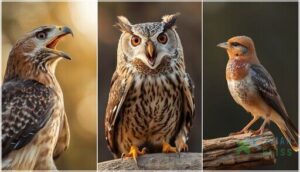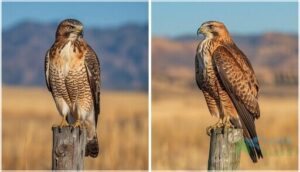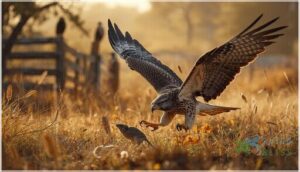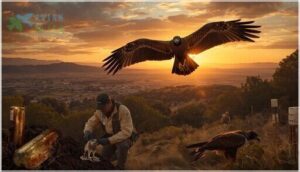This site is supported by our readers. We may earn a commission, at no cost to you, if you purchase through links.
California’s skies hold a secret that most people miss: over 30 species of raptors patrol from the Pacific coast to the Sierra Nevada peaks. These predators range from the tiny American Kestrel, barely larger than a robin, to the California Condor with its nearly 10-foot wingspan.
You might spot a Red-tailed Hawk perched on a highway light pole during your morning commute, or hear the haunting call of a Great Horned Owl at dusk in your neighborhood.
Understanding these California birds of prey transforms casual sky-gazing into something more meaningful. Once you learn to identify their silhouettes, hunting patterns, and preferred habitats, you’ll realize these impressive hunters have been hiding in plain sight all along.
Table Of Contents
- Key Takeaways
- Types of Birds of Prey in California
- Habitats and Distribution Across California
- Identification and Key Characteristics
- Diet, Hunting, and Ecological Roles
- Conservation Status and Ongoing Efforts
- Frequently Asked Questions (FAQs)
- What is the largest bird of prey in California?
- What is the white raptor in California?
- What birds of prey are legal to own in California?
- What is the big hawk in California?
- What is the most common hawk in California?
- Is a California condor a raptor?
- What is the most dominant bird of prey?
- What is the most popular bird of prey?
- What are the unique features of a Golden Eagles beak?
- Can Red-tailed Hawks be found in urban areas?
- Conclusion
Key Takeaways
- California hosts over 30 raptor species across diverse habitats, from the tiny American Kestrel to the 10-foot wingspan California Condor, with many thriving in urban areas alongside their traditional wilderness territories.
- Red-tailed Hawks dominate California’s skies as the most common raptor, with roughly 2.3 million individuals statewide and a 75% nesting success rate even in dense urban environments like Los Angeles.
- Lead poisoning from ammunition fragments and rodenticide exposure pose the greatest threats to California raptors, affecting up to 84% of urban birds of prey and causing nearly half of all condor deaths.
- Conservation efforts have achieved measurable success, with California Condor populations reaching 369 free-flying birds by 2024 and Bald Eagle nesting pairs growing 19% annually between 2011 and 2024.
Types of Birds of Prey in California
California’s skies are home to more than 30 raptor species, from powerful hunters to soaring scavengers. You’ll find hawks, eagles, falcons, owls, vultures, and even the massive California Condor across the state’s diverse landscapes.
Here’s a closer look at the main groups you’re likely to encounter.
Hawks: Red-tailed, Cooper’s, Ferruginous, and Others
Hawks are some of the most familiar California birds of prey you’ll encounter across the state. The Red-tailed Hawk, with a population around 2.3 million, lives year-round in coastal, valley, and mountain areas. Cooper’s Hawks thrive in cities, showing impressive urban adaptations. Ferruginous Hawks, the largest U.S. hawk species, winter in grasslands and agricultural zones.
Key hawk identification features include:
- Red-tailed Hawks show 75% nesting success in Los Angeles urban territories
- Cooper’s Hawks have increased dietary specialization in cities, focusing on bird prey
- Ferruginous Hawks rely on ground squirrels and open-country hunting techniques
- Migration patterns concentrate thousands of raptors along Pacific coastal flyways each autumn
- Raptor identification improves when you observe size, plumage, and hunting behaviors
These hawk species demonstrate striking dietary adaptations and habitat flexibility throughout California.
Eagles: Bald Eagle, Golden Eagle
California’s two eagle species—the Bald Eagle and Golden Eagle—rank among the state’s most impressive birds of prey. Bald Eagles are typically found near water, with around 400 breeding pairs statewide, while Golden Eagles hunt across deserts, grasslands, and mountains. With an estimated 316,700 eagles nationwide, their numbers have greatly recovered. Both species face threats from lead poisoning and wind turbines, but legal protections and monitoring programs track nesting trends and support population growth.
| Feature | Bald Eagle | Golden Eagle |
|---|---|---|
| Wingspan | 6–7.5 feet | 5.11–7.8 feet |
| Habitat | Wooded areas near water | Forests, grasslands, deserts |
| Primary Prey | Fish, waterfowl | Mammals, ground squirrels |
| Conservation Status | Delisted 2007, federally protected | Fully Protected in California |
Falcons: Peregrine Falcon, American Kestrel, Prairie Falcon
California’s falcon species—Peregrine Falcon, American Kestrel, and Prairie Falcon—showcase impressive adaptations. Peregrines recovered after DDT bans, with breeding pairs increasing and urban falcon nesting now common on buildings. Kestrels face declining population trends despite kestrel diet variations that include insects and small mammals. Prairie falcons inhabit arid grasslands, with falcon conservation drivers addressing habitat loss. You’ll find these falcon species distributed across diverse landscapes, from cliffs to cities. The peregrine falcon was federally delisted in 1999 due to successful conservation efforts.
- Peregrines dive at speeds reaching 200 mph
- Kestrels consume up to 1,000 grasshoppers weekly
- Prairie falcons prefer open, arid terrain
- Urban structures now host most peregrine nests
Owls: Great Horned, Barn, Barred, and More
You’ll find at least 14 owl species across California, from coastal areas to mountain forests. Great Horned Owls adapt to diverse habitats, while Barn Owls hunt rodents over agricultural lands, covering roughly 165-acre ranges. Barred Owls expanded westward into northern forests, and Burrowing Owls nest in the Imperial and Central Valleys. Rodenticide exposure affects 62% of sampled owls, raising conservation concerns for these nocturnal hunters.
| Species | Primary Habitat | Conservation Status |
|---|---|---|
| Great Horned Owl | Forests, deserts, riparian areas | Stable |
| Barn Owl | Agricultural fields, grasslands | Common, rodenticide threat |
| Barred Owl | Northern conifer forests | Expanding range |
| Burrowing Owl | Grasslands, agricultural areas | Declining, special concern |
Vultures and Kites: Turkey Vulture, White-tailed Kite
You’ll encounter two distinctive species that fill unique roles among California birds of prey. Turkey Vultures excel at vulture scavenging across most habitats, using their sense of smell to locate carrion over 24–32 km ranges. White-tailed Kites specialize in kite hunting—hovering over grasslands to catch voles.
Both face rodenticide threats, and population fluctuations in kites reflect changing prey availability and habitat conservation needs.
California Condor and Other Rare Raptors
Among California’s endangered species, you’ll find the California Condor leading conservation efforts. With 364 wild birds in 2024, condor reintroduction programs face ongoing challenges:
- Lead poisoning from ammunition fragments remains the top mortality cause
- Avian influenza killed 21 condors in Arizona–Utah during 2023
- Habitat conversion threatens Swainson’s Hawks and Northern Spotted Owls
These threatened and endangered raptors require intensive raptor conservation efforts to survive.
Habitats and Distribution Across California
California’s raptors aren’t tied to just one landscape—they’ve spread out across deserts, coastlines, mountains, and even city parks. Each species has carved out its own niche, whether that’s hunting along the rocky shores or nesting on downtown skyscrapers.
Let’s look at where you’ll find these birds and how they’ve adapted to California’s diverse environments.
Coastal, Mountain, and Inland Habitats
You’ll find California birds of prey across dramatically different landscapes, each hosting distinct raptor communities. Coastal cliffs support peregrine falcons on sea-facing ledges with marine prey access, while golden eagles occupy rugged mountain slopes above 1,200 meters. Agricultural landscapes in the Central Valley attract white-tailed kites and wintering bald eagles to grasslands and wetlands.
Cross-zone movements connect these habitats—condors travel 250 kilometers between nesting and foraging areas, demonstrating how habitat connectivity and elevational ranges shape California bird species distribution despite ongoing habitat fragmentation.
Urban and Suburban Adaptations
Many raptors now thrive in California’s cities, turning backyards and skyscrapers into prime hunting grounds. By 2025, Los Angeles alone documented over 750 raptor territories—Cooper’s hawks and red-tailed hawks dominate suburban neighborhoods, while peregrine falcons nest on downtown high-rises.
Urban nesting success rates reach 75–78%, but challenges remain:
- Rodenticide exposure affects 84% of urban predatory birds
- Light pollution disrupts nocturnal migration and stress hormones
- Territory density creates competition in developed landscapes
- Behavioral shifts include hunting in residential yards
- Habitat fragmentation limits movement between urban patches
Despite these threats, behavioral flexibility helps California birds of prey adapt to metropolitan environments.
Migratory Vs. Resident Raptor Species
California birds of prey exhibit striking diversity in their migratory strategies. Some species travel thousands of miles along the Pacific Flyway, while others remain year-round residents. Mixed strategies occur within single species—peregrine falcons breeding in northern latitudes migrate to South America, yet coastal California individuals stay put.
| Species | Strategy | Movement Pattern |
|---|---|---|
| Red-tailed Hawk | Mixed | Northern migrants overlay resident populations in winter |
| Cooper’s Hawk | Migratory | Peaks in September at coastal watch sites |
| Golden Eagle | Resident | Remains year-round in interior mountains |
Migration triggers include photoperiod changes and food availability. Residency factors depend on habitat quality and prey abundance throughout the seasons. Sharp-shinned hawks and Cooper’s hawks dominate fall passage, comprising over 50% of coastal migrants. Population overlap creates temporary influxes during migration windows, especially along ridgelines funneling southbound raptors toward the Marin Headlands.
Understanding these raptor habitats and bird migration patterns helps predict when and where to observe different California birds of prey throughout the year.
Key Birdwatching Regions and Hotspots
You’ll find some of the best birdwatching in California at migration hotspots like Hawk Hill in the Marin Headlands, where roughly 30,000 raptors funnel through each fall.
Wintering grounds in the San Jacinto Valley and Sacramento refuge ecology sites draw over 300 individuals during peak months.
Coastal regions, Central Valley habitat, and even urban habitats now support diverse California birds of prey year-round, offering outstanding bird watching resources.
Identification and Key Characteristics
When you’re out in the field, knowing what you’re looking at makes all the difference. California’s raptors share some features, but each species has distinct traits that set it apart once you know what to watch for.
Let’s break down the key characteristics that’ll help you identify these birds with confidence.
Size, Wingspan, and Plumage Differences
When you’re identifying raptors in California, size comparisons and wingspan ratios become your most reliable tools. Birds of prey identification starts with recognizing that California Condors can reach 9.8-foot wingspans—nearly double a Turkey Vulture’s spread.
Raptor physical characteristics also include plumage variations: adult Red-tailed Hawks sport rusty-red tails, while juveniles show brown banding. Molting patterns and age differences further complicate raptor plumage, as Golden Eagles take five years to develop their signature golden napes.
Common Calls and Behaviors
Once you’ve noted plumage and wingspan, listen for vocalization types that separate species. Red-tailed Hawks scream for 2–3 seconds during flight, while Great Horned Owls hoot at 300–400 Hz in winter courtship displays. American Kestrels produce “klee” alarm calls—3–6 notes in rapid succession.
Watch for postural cues too: owls lean forward when hooting, and condors use body language and hissing as social signals at feeding sites.
How to Distinguish Similar Species
Separating look-alikes takes practice, but you can master raptor identification using five key clues. Compare size and wingspan first—Ferruginous Hawks span 52–56 inches versus Red-tails at 45–52. Check plumage variations: Prairie Falcons show dark “armpits” underneath, while Peregrines don’t.
Watch flight patterns and habitat cues—Zone-tailed Hawks mimic Turkey Vultures in dihedral soaring. Sharp-shinned Hawks show square tails; Cooper’s Hawks display rounded tips.
Vocalizations help confirm uncertain sightings in the field.
Field Guide and Resource Recommendations
Once you’ve practiced distinguishing look-alikes in the field, you’ll want reliable references to sharpen your bird identification skills. Here are four go-to resources for mastering California birds of prey:
- Printed Field Guides – “The Sibley Guide to Birds” and “Birds of Prey of the West” illustrate plumage variations across ages and seasons.
- Digital Apps – Sibley and Audubon apps offer portable species accounts with vocalizations.
- Online ID Courses – Cornell’s Bird Academy delivers 13 lessons on raptor identification.
- Local Workshops – Golden Gate Raptor Observatory runs seasonal classes at prime bird watching hotspots, and conservation resources from U.S. Fish and Wildlife deepen your habitat and species identification knowledge.
Diet, Hunting, and Ecological Roles
Understanding what California’s birds of prey eat and how they hunt reveals why they’re so important to our ecosystems. Each raptor species has developed its own hunting playbook, from lightning-fast aerial strikes to patient ambushes from a perch.
Let’s break down their feeding habits, hunting methods, and the essential roles they play in keeping nature balanced.
Typical Prey and Feeding Habits
California raptors are small-mammal specialists—you’ll find that micromammals make up roughly 74% of prey items in many species’ diets. Red-tailed Hawks and Cooper’s Hawks hunting in grasslands primarily target voles, mice, and pocket gophers. Barn owls in vineyards consume around 3,400 rodents annually per family, providing essential ecosystem services.
Seasonal diets shift with prey availability, and researchers use pellet analysis alongside field observations to document these bird feeding habits accurately.
Hunting Strategies and Techniques
Stoop diving lets Peregrine Falcons hit 200 mph when they plunge from over half a mile up—you’re watching one of nature’s most lethal raptor hunting techniques.
Red-tailed Hawks prefer perch hunting from poles and fenceposts, while American Kestrels use hovering tactics over grasslands.
Nocturnal hunting specialists like Barn Owls deliver roughly 2.5 rodents per chick nightly, and Golden Eagles sometimes use cooperative strategies on larger prey.
Role as Apex Predators and Scavengers
You’re seeing dominant predators at work when California birds of prey regulate rodent population control and deliver essential ecosystem services. A single Barn Owl family consumes 3,000–5,000 rodents per breeding season, offering socioeconomic benefits to farms.
California’s birds of prey deliver vital ecosystem services—a single Barn Owl family consumes thousands of rodents per season, benefiting farms and natural balance
Meanwhile, avian predators like Turkey Vultures handle carrion removal, processing 90% of carcasses and preventing disease spread.
However, toxin interactions from rodenticides poison 82% of tested Cooper’s Hawks, undermining raptor hunting techniques and their ecological role of birds of prey.
Seasonal Variations in Diet
You’ll notice that prey availability drives dramatic changes in what California birds of prey eat throughout the year. White-tailed Kites take mammals in 90% of hunts during vole peaks, dropping to 60% in crash years. Urban diets shift toward rats and pigeons when these become abundant, while migratory shifts send Prairie Falcons from summer ground squirrels to winter passerines.
These seasonal patterns affect contaminant exposure and physiological impacts, shaping bird diet and feeding habits across habitats.
| Season | Primary Prey Shift |
|---|---|
| Spring/Summer | Ground squirrels, small mammals dominate breeding diets |
| Autumn | Migratory shorebirds, waterfowl increase in coastal zones |
| Winter | Urban rats, pigeons replace declining mammal populations |
| Year-round (Urban) | Synanthropic prey like Rock Pigeons remain stable |
| Vole Crash Years | Birds and insects compensate for lost mammal prey |
Conservation Status and Ongoing Efforts
California’s birds of prey face real challenges, from disappearing habitats to invisible threats like lead poisoning and rodenticides.
Understanding which species are struggling—and why—helps you appreciate the conservation work happening across the state.
Let’s look at the current status of these raptors, the dangers they’re up against, and the programs working to protect them.
Threatened and Endangered Species
You’ll find several California birds of prey facing serious survival challenges. The California Condor remains endangered, with only 369 free-flying birds globally as of 2024. Northern Spotted Owl populations have crashed 31–55% since the 1990s, competing with invasive Barred Owls.
Burrowing Owls have vanished from 25% of their former range, with numbers dropping roughly 8% yearly, making wildlife conservation and California Wildlife Protection critical.
Major Threats: Lead, Rodenticides, Habitat Loss
Three major dangers threaten California birds of prey today. Lead ammunition fragments in carcasses poison condors and eagles—nearly half of condor deaths trace back to lead. Rodenticide exposure affects 42% of condors through contaminated prey.
Habitat loss and wildfire impacts destroy nesting sites and fragment hunting grounds, with fires like the 2018 Woolsey Fire altering critical territories. These threats demand immediate conservation strategies.
Conservation Programs and Legal Protections
Several layers of protection safeguard California’s raptors. Federal oversight is enforced by the Migratory Bird Treaty Act and Bald and Golden Eagle Protection Act, with penalties reaching $5,000 per violation.
State law under Fish and Game Code sections 3503 and 3503.5 prohibits disturbing nests or taking birds of prey.
Conservation efforts include the California Condor Recovery Program, which operates intensive captive breeding and reintroduction initiatives. Rehabilitation centers like the California Raptor Center and Ojai Raptor Center treat hundreds of injured raptors annually, releasing about 60% back into the wild.
Current Population Trends and Monitoring Initiatives
California’s birds of prey monitoring shows encouraging signs. The global condor population reached 566 individuals by late 2024, with 369 flying free—a 7.3% yearly increase. Bald eagles showed 19% annual nesting pair growth between 2011 and 2024.
The Golden Gate Raptor Observatory tracks migration along the Pacific Flyway. Integrated monitoring through the California Natural Diversity Database and rodenticide surveillance programs help wildlife management teams assess raptor identification and classification trends across species.
Frequently Asked Questions (FAQs)
What is the largest bird of prey in California?
You’ll spot the California condor soaring with its enormous 10-foot wingspan—North America’s largest flying land bird, dwarfing Golden Eagles in size, weight, and sheer presence across rugged southwestern canyons.
What is the white raptor in California?
You’ll most commonly see the White-tailed Kite—that distinctive white raptor in California with black shoulder patches.
This hovering hunter thrives across grasslands, particularly in the Central Valley and Bay Area, feeding mainly on voles.
What birds of prey are legal to own in California?
You can’t keep raptors as pets in California. Falconry licensing is the only legal path—apprentice restrictions limit beginners to one red-tailed hawk or American kestrel, while master falconers may possess multiple birds under strict wildlife conservation regulations.
What is the big hawk in California?
You’ll most often see the Red-tailed Hawk, California’s most common large raptor.
However, the Ferruginous Hawk is technically bigger—it’s North America’s largest hawk, sometimes mistaken for a small eagle in open country.
What is the most common hawk in California?
You’ll find Red-tailed Hawks dominate California’s skies. Their habitat breadth spans grasslands to suburbs, and seasonal residency paired with soaring behavioral traits makes them the most abundant hawk—unmistakable through sharp bird identification and raptor monitoring statewide.
Is a California condor a raptor?
Yes, the California Condor is classified as a raptor. Despite being a scavenger rather than a hunter, conservation agencies and wildlife organizations recognize vultures as birds of prey due to their hooked beaks and ecological role.
What is the most dominant bird of prey?
Crowning a single king isn’t straightforward—dominance depends on your yardstick.
Red-tailed Hawks rule by sheer numbers throughout California, while Golden Eagles reign as top predators in open country. Bald Eagles dominate aquatic habitats, and California Condors win on size alone.
What is the most popular bird of prey?
Red-tailed Hawks top California’s raptor sighting frequency charts—you’ll spot them everywhere from coastal cliffs to urban parks.
Their widespread distribution, distinctive appearance, and striking urban adaptation make them the state’s most recognized bird of prey among birdwatchers.
What are the unique features of a Golden Eagles beak?
A Golden Eagle’s beak curves sharply downward, forming a powerful hook that tears flesh efficiently. Continuous keratin growth maintains its strength through repeated feeding. The yellow cere contrasts with the dark tip.
Can Red-tailed Hawks be found in urban areas?
You’ll spot Red-tailed Hawks thriving throughout California’s cities and suburbs.
These urban raptors adapt remarkably well to density gradient effects, nesting on buildings and towers while hunting synanthropic prey in parks and suburban habitats.
Conclusion
Most people think California birds of prey are rare sightings reserved for wilderness trips. The irony? These raptors hunt above shopping centers, nest in city parks, and perch on your neighborhood power lines daily.
You’ve likely passed dozens this week without a second glance. Now that you can identify their silhouettes, calls, and habits, you won’t miss them anymore.
The secret wasn’t finding where raptors hide—it was learning to finally see them.
- https://wildlife.ca.gov/Conservation/Birds/Raptors
- https://pmc.ncbi.nlm.nih.gov/articles/PMC12562076/
- https://bioone.org/journals/journal-of-raptor-research/volume-58/issue-3/jrr2370/Population-Trends-of-the-Ferruginous-Hawk-Buteo-regalis-Wintering-in/10.3356/jrr2370.full
- https://friendsofgriffithpark.org/raptor-study-final-report/
- https://www.parksconservancy.org/programs/golden-gate-raptor-observatory

